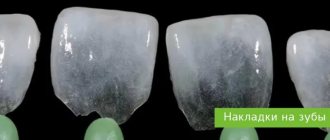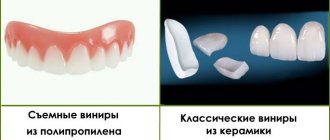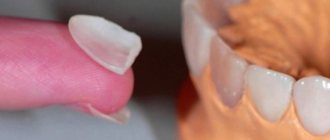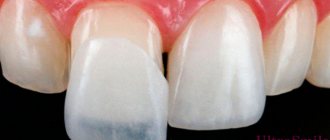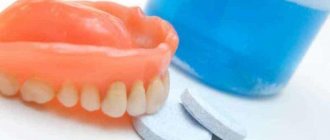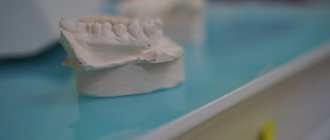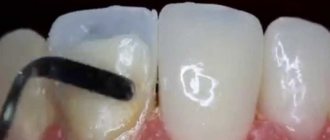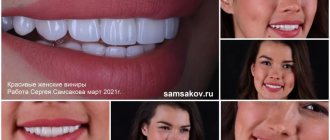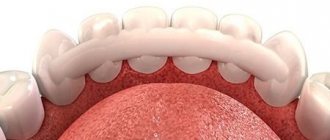Removable veneers – what are they and how to use them? How justified is such a purchase?
In pursuit of a flawless smile, many are often tempted by the advertising promises of manufacturers of inexpensive removable veneers. In such cases, most often we are talking about budget cosmetic mouthguards made of plastic or sets of template plates, which you need to attach to your teeth yourself using dubious glue from the packaging. Both options have many significant disadvantages. Therefore, in today’s article we will talk in detail about whether it is possible to insert removable veneers yourself and whether they are worth using at all.
average cost
The cost of installing composite veneers in different cities of Russia may vary. The price of a service within the same locality, but provided by different dental clinics, will also vary. The difference in cost is determined by many reasons:
- clinic level;
- volume of preliminary work;
- use of anesthesia or refusal of it;
- choosing the installation method;
- materials used, etc.
The minimum price for the entire procedure in Moscow is about 3,000 rubles, while the maximum cost can be 5 times higher.
To correctly calculate the necessary funds, you should familiarize yourself with the price list for services in advance. Such information is always available on the websites of clinics and dental centers.
Removable veneers - what is this design and what are its features?
What are removable veneers really?
So-called removable veneers have nothing to do with real ones. When describing this method of quick cosmetic smile restoration, it would be inappropriate to ask questions about which doctor places such veneers and whether it hurts to place them at all. The fact is that most often this term refers to cosmetic removable mouth guards, which are put on the entire dentition at once and, in theory, thus transform the smile. In practice, everything is completely different.
Such designs usually have template sizes, so they simply do not fit in most people’s mouths. And even if you manage to capture them, you definitely won’t be able to talk to them normally, much less chew food.
There is another variety - again, template linings for each tooth. Such plastic plates are sold in sets of 70 pieces at a time, with a brush, tweezers and special glue. However, no one knows how safe the composition of this glue is. And such “veneers” are unlikely to look natural and beautiful on the teeth. Therefore, experts in the field of aesthetic dentistry strongly do not recommend the use of such products, since they can not only be useless, but even harmful to the tissues of the oral cavity and the body as a whole.
Features of care
Maintenance of microprostheses is standard. Hygienic cleaning after treatment must be carried out twice a day. It is important to remember the role of floss and irrigator in the oral care process. Also, artificial surfaces require periodic polishing. It can be done in the dental office. The procedure is simple and painless. Upon completion, the veneer becomes perfectly smooth and even, and noticeably brightens.
In order for the microprosthesis to last as long as possible, you should avoid eating too hard foods. It is also unacceptable to gnaw on any hard objects or bite anything with force.
If a person is prone to bruxism, it is recommended that he wear special mouth guards at night. They protect the dentition in case of involuntary grinding, prevent the enamel from wearing away and pieces of the extended edges from breaking off.
An examination by a dental hygienist is recommended twice a year.
Types of temporary microprostheses, including preparation and creation of impressions
What types of removable veneers are there?
- temporary plates - such plastic overlays are installed by the doctor in the dental office, after preparing and preparing the teeth for the installation of permanent structures. They will need to be worn until permanent ceramic or, for example, zirconium plates are ready. By the way, many people are interested in the question of how old people are to get veneers. So, a similar procedure is performed on patients at least 18 years of age,
- removable template mouthguards and overlays - you can buy them on the Internet, pharmacy or cosmetics store. However, they are really of little use - neither cosmetic mouth guards nor overlays with a cheap adhesive composition will stick to the teeth for a long time and reliably. Moreover, they can damage the enamel and mucous membranes, provoke inflammation,
- individual removable Snap-On Smile - such cosmetic prostheses are made from impressions exclusively in the laboratories of the American company DenMat in the USA or Europe. That is, in a Russian clinic you can undergo all the preparatory procedures, but you will have to wait about a month for the arrival of the finished plates. Such designs, by the way, also allow you to disguise missing teeth. However, experts do not recommend wearing them on a permanent basis - this is an acceptable option as a temporary measure.
Work examples
All works
Replacing composite veneers with ceramic ones
Restoring dental aesthetics with veneer
All works
Sign up for a consultation
three ROOTT specialists + diagnostics as a gift
Is it possible to install veneers without damaging the enamel?
If we talk exclusively about removable aesthetic mouthguards, then standard polymers, silicone, polypropylene and other types of plastics of appropriate shades are usually used for their manufacture. All these are inexpensive materials that can be easily processed and painted. Such structures are installed in the oral cavity without any grinding of teeth or taking impressions. However, due to their standardized size, such structures practically do not stay in the oral cavity; it is impossible to speak normally with them, chew food, or even smile.
On a note ! There is a separate type of cosmetic removable dentures Snap-On Smile. They are made individually for each patient, so they require preliminary impressions. The development belongs to the American company DenMat, so the prostheses themselves are created in the laboratory of the manufacturing company. Such onlays stay in the mouth much better and allow you not only to transform the aesthetics of your smile, but also to visually restore missing teeth. However, this option can only be considered as a temporary solution. Read more about Snap-On Smile dentures in our separate article.
However, temporary onlays can also look like real classic ones, that is, one thin plate for each tooth. In dentistry, such products are usually made of plastic and fixed with temporary adhesive until full-fledged microprostheses made of ceramic or, say, zirconium are ready. In this case, preparation and making impressions are an integral stage of smile restoration.
What if you choose subtle options?
Sometimes, when choosing ultra-thin plates, for example, “Lumineers” from the same DenMat company, it is possible to completely avoid turning the living enamel, but here we are talking about full-fledged permanent veneering. On sale you can find cheap template analogues - plastic overlays in a set with glue of dubious quality. Such products cannot be of high quality and, as noted above, it is better to avoid them so as not to harm the enamel and gums
Composite or ceramics: which is better?
| Ceramic veneers | Composite veneers | |
| Aesthetics | High, due to the ability of ceramics to transmit light, similar to natural enamel, they are not subject to pigmentation, staining, or staining | They do not provide complete naturalness and change color over time. |
| Strength | High | Low |
| Treatment time | Up to 3 weeks, due to the need to make plates in the laboratory | In one visit |
| Fabric processing | Significant (except for lumineers, E-max) | Minimum |
| Price | Relatively high | Low |
| Life time | 10 years (E-max up to 25 years) | 3-5 years |
What glue is used to install removable veneers and its features
So-called removable veneers, which look like mouth guards, are simply placed on the teeth. To secure them, no adhesive compounds are needed. Although we cannot talk about any reliable fixation in the case of template cosmetic prostheses. No complicated instructions for their use are required either.
The removable plates, which follow the shape of the teeth and are sold in packs of 70 pieces, have a template shape. They are attached using a special glue that comes in each set. The kit usually also includes a special brush and tweezers. But if professional dentistry uses proven compounds, then in this case it is not entirely clear what exactly the composition of the glue is and how safe it is for the body. Therefore, dental experts strongly recommend not to risk your health.
Classic non-removable products are fixed with a special heavy-duty adhesive; subsequently, you will not be able to remove them yourself. But for Cerinate (DenMat) lumineers they use a special patented adhesive composition, which additionally has protective properties for the enamel[1].
Difficulty of choice
The choice of color depends on the number of restorations. For single teeth, it is important to choose a shade so that the restored tooth does not stand out. If the plates cover the entire visible dentition, then everything depends on the wishes of the patient. However, the dentist should explain the main approach to how to choose the color of veneers:
- Skin, hair and eye color
must be taken into account . The lighter the skin and hair, the less the teeth, even radically white ones, will stand out. - Eyes and teeth
are the first things people pay attention to. Dentists recommend choosing shades that match the whites of your eyes. - The size of the veneers
plays a role. Ultra-white colors visually enlarge the veneers, so for large teeth it is better to choose natural-colored veneers.
Fixed plates - indications and installation
But let’s return to the question of what veneers and lumineers are in the classical sense. We are talking about very thin overlays that are fixed on the front side of the front teeth in order to hide their aesthetic defects, that is, to correct the shape and size of incisors and fangs, to disguise too large gaps between the teeth, to give the enamel a beautiful snow-white shade and vibrant shine. After such a procedure, your smile can be transformed beyond recognition.
In their classic form, veneers are immediately recognizable
The plates themselves are made from durable and aesthetic materials, most often from pressed ceramics or zirconium dioxide. There is also the option of more budget-friendly composite plates. By the way, with the help of a composite, teeth are literally grown in a direct way - the front surface of the incisors is covered with a photopolymer and immediately illuminated with a polymerization lamp, that is, all manipulations are carried out directly in the patient’s oral cavity.
If we talk specifically about the indirect method, then the thickness of one such structure usually varies from 0.6 to 0.8 mm. Therefore, before installing microprostheses, the doctor first grinds off a small layer of enamel in order to preserve the anatomical parameters and aesthetics. Each plate has a small protrusion at the base, which, after fixing the product, neatly overlaps the cutting edge, which increases its strength and improves other performance characteristics.
“When I was getting veneers, I agreed to have them trimmed myself, but honestly, I didn’t think that so much would be removed! I almost cried when I saw my smile after the dissection. Thank God they gave me removable plastic pads, otherwise I don’t know how I would have walked. With plastic ones, of course, it’s not very convenient, but what can you do? Now I’m waiting for my ready-made teeth to arrive from the States.”
Vikki, review from the women's forum woman.ru
But there is another option - ultra-thin plates with a thickness of 0.2-0.3 mm. The most popular brand that produces these types of pads is the Lumineers brand, which belongs to the DenMat company. To create ultra-thin plates, they use a special patented material called Cerinate, which is both highly durable and almost flawless in aesthetics. In some cases, when choosing ultra-thin onlays, it is possible to completely avoid grinding your living enamel.
Fixed plates are installed in patients using approximately the same algorithm. The universal sequence of actions is briefly described below:
Although turning the enamel is not always necessary, it is still one of the stages of action
- preparation, including treatment of carious cavities, replacement of old fillings, anti-inflammatory therapy if necessary, removal of plaque and deposits, selection of the shade of future restoration using the Vita scale,
- turning the enamel - removing a small layer of living hard tissue so that after installing the plates, the teeth do not look too voluminous and massive,
- making impressions or 3D scanning of the internal structures of the oral cavity,
- conducting photometry – fixing photoparameters of facial symmetry,
- bite modeling on an articulator or using advanced digital smile design software,
- installation of temporary plastic overlays to protect ground incisors and canines and temporarily hide aesthetic defects.
Once the permanent products are ready, it is time to remove the temporary overlays. Finished permanent veneers are attached using a special heavy-duty adhesive composition.
Classic non-removable plates are the best option if you want to get a highly aesthetic and durable result. Any removable structures aimed at aesthetics are acceptable only as a temporary measure, and many of them are not suitable for use at all, being only a product of an advertising gimmick.
In what cases should you install
Attention! Typically, veneers are installed only at the request of the patient; there is no need to have indications for this. As a rule, these products are used to improve the shape and color of teeth, and also if the patient dreams of having a Hollywood smile. But still, there are some indications for which veneers are installed:
- ugly and uneven shape of teeth;
- the presence of a pronounced yellow tint of the front incisors;
- change in shade after depulpation;
- the presence of an enamel erosion process, for example, after a tooth has chipped due to any reason;
- wide spaces between teeth with an unsightly shape, as well as rotated, crowded incisors;
- can be used when other recovery methods have not provided the desired results.
Composite veneers are a method of aesthetic correction of a patient’s smile, which is used for cracks and chips in teeth, discoloration, curvature of teeth, and large interdental spaces.
How many teeth can veneers be placed on?
When answering the question of how veneers are placed, you should immediately pay attention to the fact that this kind of restoration plates are fixed only on the front teeth on their front side. By the way, such onlays are also placed on crooked teeth, but only when they have slight curvature. Usually they are recommended to be attached to all incisors and canines that fall within the smile zone, and these are 10 front upper and 8 front lower teeth. Veneers are placed using a special technology, so only an experienced specialist can install them correctly. The use of this restoration method allows you to make a Hollywood-style smile snow-white and irresistible.
Your future smile is worth all the effort
The most popular colors
Bright shades are the most popular. Most often, patients choose shades a1, a2 and b1. These teeth look natural, but at the same time immediately attract attention with their color. Bleach is the choice of popular people. In the spotlight, on the TV screen, bright white teeth look attractive. It’s not for nothing that these colors are called “Hollywood white.” In real life, such shades hurt the eyes a little.
